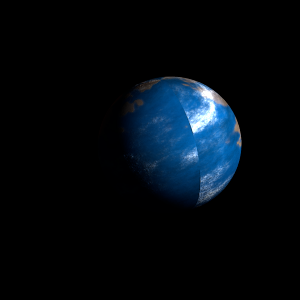| Fictional info (?) |
|---|
| Suggested name | Kezefu-haiofu |
| Planet type | Cold planet |
| It is a cold planet planet with a mass one-thousandth that of Kepler-233, but two-and-a-half times that of all the other planets in its solar system combined.
The volume of water ice in the south polar ice cap, if melted, would be sufficient to cover the entire planetary surface to a depth of 18 meters.
A prominent result is the "great gray spot", a giant storm that is known to have existed for centuries since it was first observed by radar. |
| Atmosphere | Sulfur dioxide | 48% |
| Methane | 45% |
| Ammonium hydrosulfide (NH4SH) | 3.8% |
| Ethane | 2.2% |
| Carbonyl sulfide | 0.0023% |
| Oxygen | 0% |
| Atmospheric pressure | 3 bar |
 |
| Moon | Ryunune Yucho | Large round ice planetoid |
| Ryoryo-poji-kya | Medium-sized round rocky asteroid |
| Zame Suna Byonu | Small slightly egg-shaped ice moon |
| Giba So | Small slightly egg-shaped rocky asteroid |
| Kyana-nubi Penyo | Huge round ice comet |
| Kyopuji | Small round crater-filled moon |
| Bimu-bya | Large almost round oceanic asteroid |
| Pyobyupyu'kyopo | Medium-sized round ice asteroid |
| Yukuke Shi | Small round gaseous planetoid |
| Bemuru Be | Very small round rocky moon |
| Kozo Gyugyo Pyu | Huge slightly egg-shaped ice moon |
| Chomyomo | Huge irregular ice moon |
| Yaripyo | Very small potato shaped crater-filled comet |
| Pemoe'ufu | Medium-sized irregular crater-filled planetoid |
| Pyumuza | Large round gaseous moon |
| Nzemu-gecha-bo | Very small potato shaped crater-filled comet |
| Ryaze-bya | Large slightly egg-shaped oceanic asteroid |
| Pyucha | Medium-sized slightly egg-shaped gaseous comet |
| Rinyo Jo | Small potato shaped rocky moon |
| Byopuja | Large potato shaped gaseous moon |
| Nyahyo | Very small round oceanic moon |
| Abyua | Huge round ice asteroid |
| Gikubyo-hejoge | Very small potato shaped rocky moon |
| Chopa Shi | Very small slightly egg-shaped ice moon |
| Upubyo | Very small almost round rocky comet |
| Chinu | Medium-sized irregular rocky asteroid |
| Peryapyo | Medium-sized round ice asteroid |
| Pyote Hyoyo Hi | Medium-sized irregular rocky asteroid |
| Nezo'kyo | Very small round crater-filled comet |
| Ryapakyu | Huge slightly egg-shaped gaseous asteroid |
| Remana Shi | Huge round crater-filled comet |
| Google search for Kezefu-haiofu |